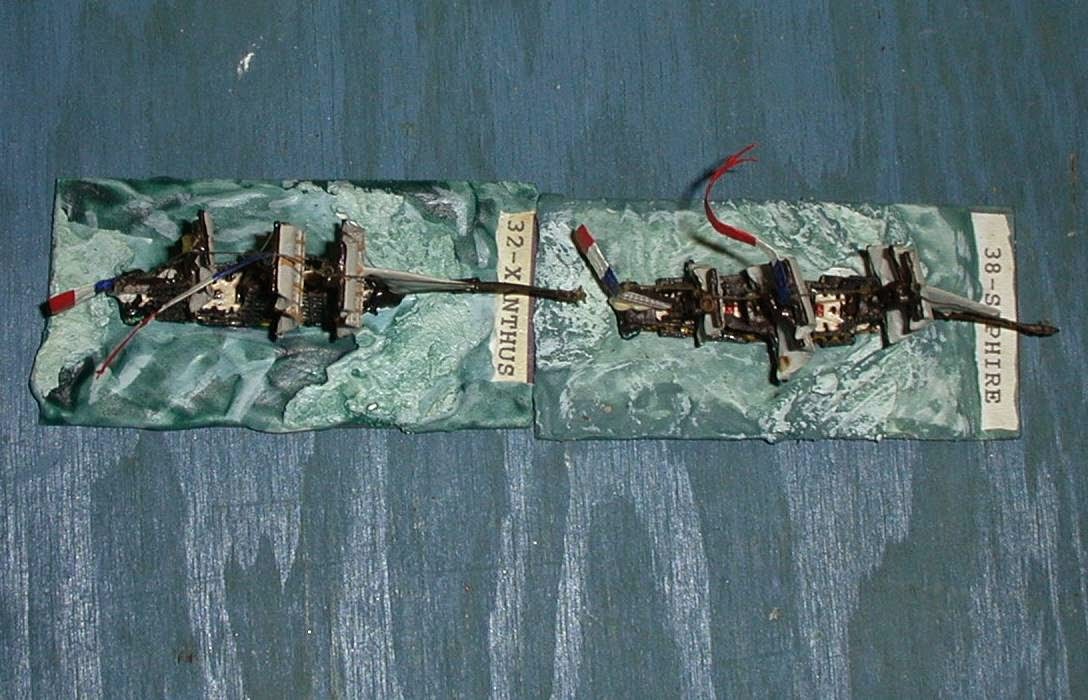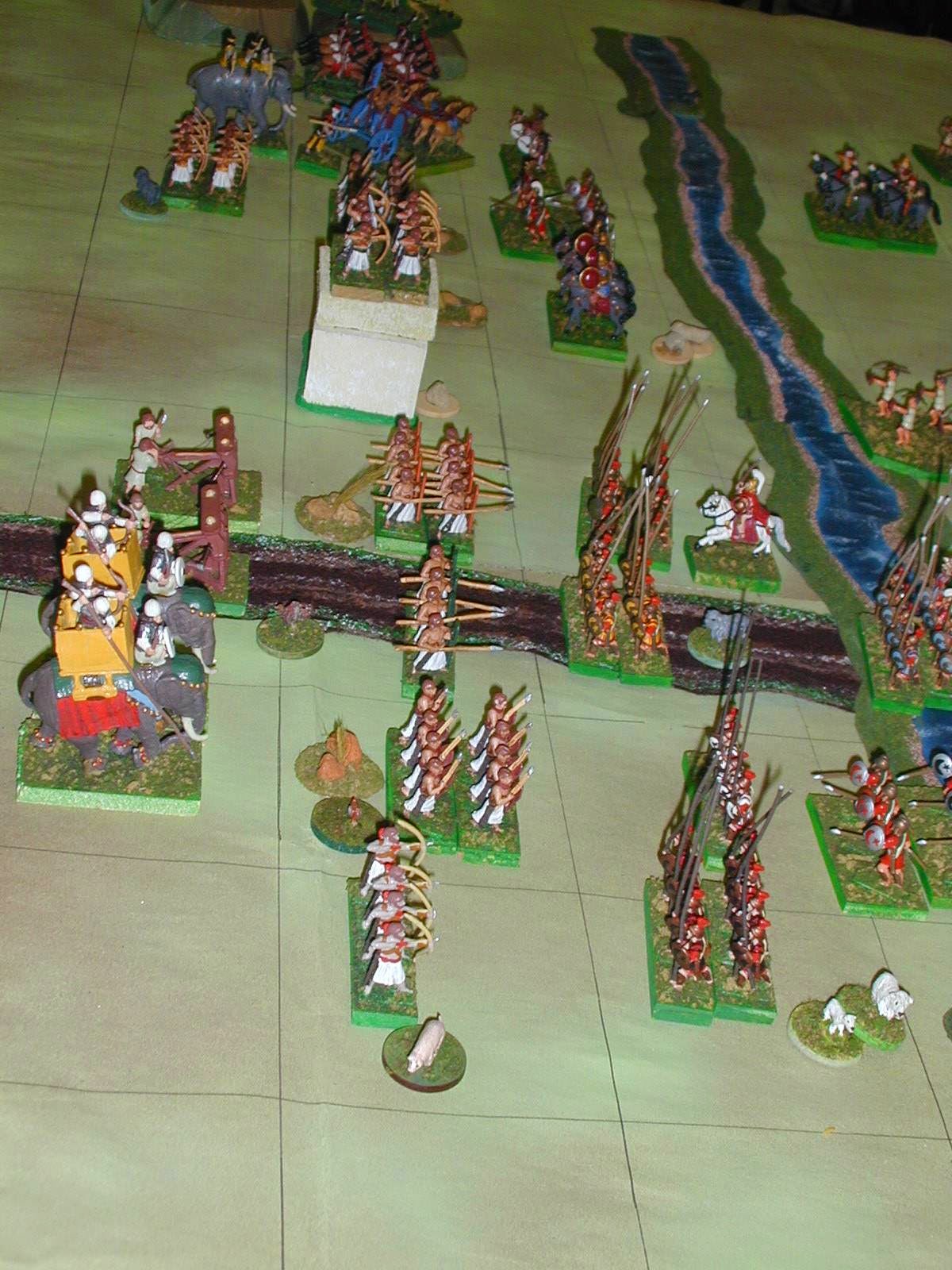The 26th running of
Ellis Con took lace at the Ellis Technical School in Danielson, CT. yesterday. I had to miss it last year, and 2 years ago the old Aircraft Hangar where it had been held for 24 years was being refurbished into a brand new gymnasium, the convention taking place in the old Gym on it's last day of existence before it too was slated for re-purposing. However, the new gym was off limits to us - unconfirmed rumor has it the the powers in charge have declared that the Gym is only to be used for league sanctioned athletic events. In any event, much of the rest of the school has also undergone major revisions, doubtless at the costs of many millions of dollars. the end result is certainly very nice, especially compared to the mid 1960's style previously evident. Ellis Con is and has always been a multi genre convention - miniatures, board and card games, including Historical, Science Fiction, and Fantasy genres. Computer games were also included this year. As a result of the gym being off limits, the Miniature games,some board games, and dealers were in the very modern, airy and well lit cafeteria, some other games were in the ? media center, and others in the atrium. For the most part this worked OK, with a few growing pains as are to be expected from any change in a venue. Still, I must admit the Gym thing was an unpleasant reminder of one of the least attractive aspects of High School - the exaggerated status given to athletics and athletes. Fortunately, on average we geek types win out in later life (most doctors are on the geeky side to some degree - and thank goodness!). That introduction aside, as they say - on with the show!
I left my home shortly after 8 AM, and arrived at the school shortly after 10 AM. it is a solid 2 hour drive from my home on the far Western side of the state to Danielson (in the Town of Killingly), on the far North Eastern side (nearly in Rhode Island). Thus it is closer to much of Massachusetts and RI than Western Connecticut. As a result, I decided to start my game at 1PM instead of 10AM. It was actually a bit confusing finding the Convention entrance, which had changed notably from past years, but a brief search was all it took to determine it was now the front door!.
The time cushion arrival gave m,e a chance to check out some of the other games. The next few shots are from a great looking game set in "Darkest Africa" Zululand type enthronement, run by good friends and fellow
HAHGS members Greg Hanson and Joe Fish.
They created a fantastic looking game on a roughly 5 foot square table, including some Step Pyramids, Elephant grass, rivers and streams..
native villages, boats, wild animals...
Zulus and even a kraal. The rules used were "In Her Majesty's Name", which I have a copy of. I'd have liked to have gotten in on this one!
Vic Gregiore of Battle Group Boston used his impressive damaged city terrain for a game titled "Rumors of Cat and Mouse".
Jim Smith ran this nice looking 15mm ACW tutorial game.
It also happened to be on the table labeled as the table I was to use for my 1PM game. It was obvious that they would be lucky to be done by 1 PM, to make no mention of taking their game down, and then setting mine up. There were no other open tables visible, so a mild sense of panic began to set in. Fortunately, I spotted another table nearby of the right size piled with coats and surplus gaming supplies, and unlabeled as to any game to be run thereupon. I therefore decided to Carpe Mensam and commenced to clear of one end of the table like I was in charge. I set up one of the two match ups, and by the time I was done with that, the nearby gamers had taken the hint and vacated the other half as well. Once the tables were set up, I headed to the food line for the traditional Ellis Con lunch of a large hot meatball grinder; once again thjis year they were both excellent and a superb value.
Ellis Con doesn't do event registration, so it is a walk up system. This has advantages and disadvantages. In my case this year, shortly after 1 PM,. I wound up corralling one interested onlooker, a fellow HAHGS member that I don't recall meeting previously, and we started to play
Legio Quarternarius. This was in part my fault - I had planned to self promote a bit on the Ellis Con FB page, but professional and personal challenges the past 3 months have been darn near overwhelming, so that just didn't happen.

We chose to play the Macedonian/Indian match up. He chose the Macedonians. Based upon past experience, I had given the Indians , who have excellent missile power but only fair melee troops, and advantage by placing a stream across the center of the table and towards their deployment side. While this mimicked the historical encounter between Porus and Alexander, it was probably a bit too much of an edge! Seen here are the Indian positions at the end of Turn 1. The poor morale of their infantry is already evident, 2 MI Archer units having already failed morale!
The Macedonian left flank and center - note the 5 units of HI pikemen in the center, which are incredibly powerful in Melee - as long as they are not outflanked!
The Macedonian player prepares to shoot one of his Catapults (onangers) at the start of urn 3.
I thin this may have been one of the shots where he hit his own troops. He actually did quite well using the somewhat finicky contraptions for the first time!
At the start of Turn 3, the Macedonians launched their attack - seen here, the Companions attempt to whup up on some archers - although they have 2 handed swords, so they aren't quite as wimpy as they look, The Indian chariot will support them as well. the result was a destroyed archer unit, but also loss of the Companions. On my 3rd turn I adjusted my positions but mostly stayed out of melee, hoping to use more of my bow fire and catapult shots to whittle down his powerful Melee troops. I was fairly successful in that.
On the Macedonian 4th move, he attacked all out, as well he needed to - here Thracian Peltasts, Hypaspists, and some more Heavy cavalry can be seen entering melees.
In the center, the Macedonians manage to get 4 of their 5 heavy pikes into action. My Indian Infantry have already taken considerable losses (MI archers make great targets!). This is gonna hurt!
And indeed it did; I managed to eliminate the Thracian Peltasts, but aside from that he won all but one of the remaining melees, and that one left my MI javelin unit with but one more hit before it too was eliminated. Center... what center?!
I forgot to take more pictures, but on my part of the 4th turn, I did my best shooting of the day with my catapults and missile troops, and then was able to take advantage of the vulnerable flanks of the Pikemen, as well as getting my extra powerful Pachyderms into the fray. That evened things out quite a bit, and then I was lucky to win the choice of Move for the next turn, and took the First move - that pretty much eliminated the rest of his heavy troops, and on his part of the Turn he wisely called it a day. We wrote and played Legio Quaternarius well before DBA came out; I think a modified pip system (or alternating movement by Commands (Right Flank, Left Flank, and Center) might take away the tremendous sting of the Double Move, especially when it happens at the critical moment. Something to think about! In any event we both had fun playing the game, which is what matters most!

Not content to run just one great game, Greg put on a second one at 1:30 PM on the same smallish table, this time "Red Beach One", the
US Marine assault on Tarawa, using Bolt Action rules. The Japanese defensive positions are seen here.
The US Marines launch a costly assault!
Japanese are well entrenched!
Marines in the surf, both living and dead.
My game finished on time, about 4:30 and I started packing it up, and hauling it all out to the car. The annual auction and door prize give away was commencing as I was clearing my game away. I had it all packed up by about 5:30, and made the long drive home, arriving about 7:30 PM. Having been up late the night before packing the car, I was pretty bushed when I got home, and went to bed by 10PM - extraordinarily early for me!
My opponent for the game, whose name has sadly slipped my aging mind, was interested in playing some Close Action, an Age of Sail game based upon "Wooden Ships, Iron Men", and it's associated Miniature set, Ship of the Line, which I am familiar with (I own a copy of SoL). I have about 30 1:1200 Napoleonic Sailing ships, so perhaps another time, my friend, with "real" ships!
In the process of setting up my game, Steve, who is the owner of the excellent
Time Machine hobby store in Manchester, CT, and the associated and totally awesome, huge gaming space across the street, The Portal. introduced himself to me. We had a nice conversation about the hobby, the TM, how to make The Portal at least self supporting financially, and other topics. He is planning on having the first Portal Con there this January 17th (Saturday) and 18th (Sunday). Unfortunately, this isn't a great weekend for me, as my wife's Birthday is the 19th, but we'll see if it might be possible to run a morning game there one day or another.
Perhaps due to the new set up and dispersed nature of the convention, one thing I missed from past conventions was the extreme helpfulness of the Simulations Club members. The new Miniatures location in the cafeteria has 2 sets of doors to the outside, but they were both locked. It was much shorter to enter the cafeteria area directly from the outside, and it was a COLD day for November, but... these doors were, once again, *locked*. Despite the excellent visibility to the outside through the glass front of the cafeteria, only Carl noticed my plight and assisted me with the door; thereafter, I carried everything else up to the Cafeteria doors, left it all outside, and then went around the long way through the front doors, and then brought it in all inside in trips, with some fancy foot work to keep the Cafeteria door open sufficiently long to make it inside with another load before it closed again. I could have asked for help of course, but I'm a pretty self reliant fellow!
They could use a few more tables (see above), but the available space will only fit so much. Some additional chairs in the gaming area would definitely have been useful as well - I didn't get one until about 2:30 PM! The convention was certainly fun and a success overall, though, and hopefully they broke their old attendance record. It is the main fundraiser for the Simulations Club, and helps defray the cost of their annual trip to Point Con, held at the US Military Academy in West Point, NY. Maybe some year I'll make that one, too!


















































